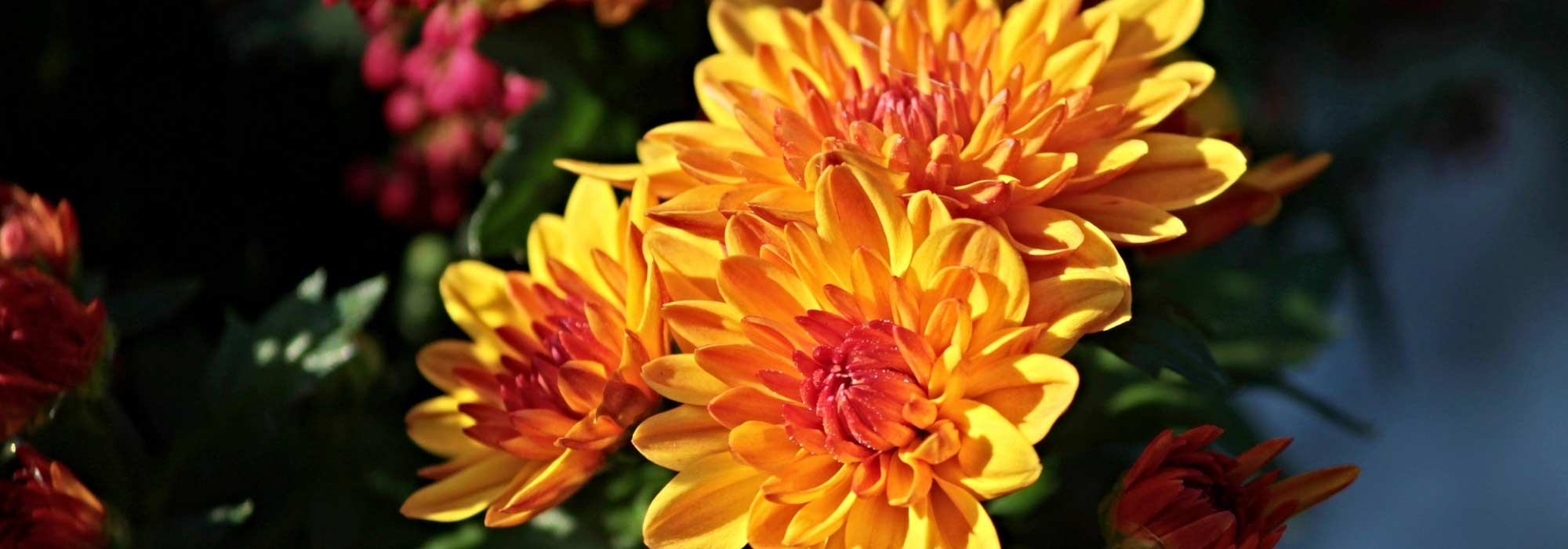

Chrysanthemum carinatum Rainbow - Tricolour Daisy
Chrysanthemum carinatum Rainbow - Tricolour Daisy
Chrysanthemum carinatum Rainbow
Tricolour Daisy, Painted Daisy, Brushstroke Daisy, Crown Daisy
Seeds sown upon receipt using the broadcasting method as indicated in the description. Waiting for them to take root and for the next colourful flowering.
Nathalie, 12/04/2021
Special offer!
Receive a €20 voucher for any order over €90 (excluding delivery costs, credit notes, and plastic-free options)!
1- Add your favorite plants to your cart.
2- Once you have reached €90, confirm your order (you can even choose the delivery date!).
3- As soon as your order is shipped, you will receive an email containing your voucher code, valid for 3 months (90 days).
Your voucher is unique and can only be used once, for any order with a minimum value of €20, excluding delivery costs.
Can be combined with other current offers, non-divisible and non-refundable.
Home or relay delivery (depending on size and destination)
Schedule delivery date,
and select date in basket
This plant carries a 6 months recovery warranty
More information
We guarantee the quality of our plants for a full growing cycle, and will replace at our expense any plant that fails to recover under normal climatic and planting conditions.

Would this plant suit my garden?
Set up your Plantfit profile →
Description
Chrysanthemum carinatum 'Rainbow' is a selection of chrysanthemums with carinate heads, offering a beautiful palette of colours in various shades of purple, orange, scarlet, pink, mauve, salmon, yellow, and white. This hardy annual plant, which is easy to grow, starts flowering 12 weeks after sowing and continues until the end of summer if faded flowers are regularly removed. Ideal for filling gaps in borders and flowerbeds, they also look beautiful in pots and bouquets, and are attractive to butterflies, bees, and other beneficial insects.
Chrysanthemum carinatum, now renamed Ismelia carinata, Ismelia versicolor, or Matricaria carinatum, is an annual plant often called the Tricolour Daisy due to the different colours present on its head-shaped inflorescences, which we call flowers. It belongs to the large family of Asteraceae and originates from the Atlantic coast of Morocco. It thrives in light, even sandy, and not too fertile soils, and has excellent tolerance to sea spray.
This 'Rainbow' chrysanthemum first forms a bushy clump about 40cm (15.7 in) tall and 30-40cm (11.8-15.7 in) wide. Its stems bear strongly dissected, slightly succulent, bluish-green leaves with a touch of glaucousness. Flowering occurs from July to October on sturdy stems about 60cm (23.6 in) tall. The head-shaped flower resembles a daisy. Its centre is composed of tiny tubular flowers that appear bluish-purple when closed. These flowers gradually open in a circular fashion, revealing their yellow stamens and then their red centre. The outer part of this daisy is made up of ligulate flowers, which means that a part of them has transformed into a long coloured petal. The base of this petal is yellow, and it can display a wide range of bright or even pastel colours, making it extremely varied. These different successions of colours add to the charm of this chrysanthemum, rightly called tricolour. It is a hardy plant that can be sown directly in place in April-May without any damage. In warm and mild climates, sowing in autumn is successful, and the plants bloom in spring, before the arrival of heat. The fruits are angular achenes with 3 faces, equipped with translucent membranous wings and topped with an egret.
The 'Rainbow' Chrysanthemums are not demanding when it comes to soil, as long as it is well-prepared, but they require sun to flower well. They integrate perfectly into a perennial plant bed, where they complement the range of colours. When sowed with cornflowers, Centaureas, poppies, or cosmos, they allow you to create a very colourful decoration in a brand new garden within a season. When sowed in pots, they provide a long-lasting solution for decorating the terrace and balcony. With excellent vase life, their flowers can be used to make beautiful countryside bouquets throughout the summer.
The ecological gesture: by sowing the 'Rainbow' Chrysanthemum in your garden, you attract pollinating insects that will enjoy its nectar and, by doing so, promote the ecosystem of your garden.
Flowering
Foliage
Plant habit
Botanical data
Chrysanthemum
carinatum
Rainbow
Asteraceae
Tricolour Daisy, Painted Daisy, Brushstroke Daisy, Crown Daisy
Cultivar or hybrid
Other Chrysanthemum seeds
View all →Planting and care
Sow Chrysanthemum carinatum in March-April directly in a sunny spot. Prepare the soil well beforehand and add some compost and sand to lighten it and facilitate the rooting of the young plants. Sow your seeds by broadcasting. Cover the seeds by sprinkling some compost on top, lightly tamp down and water generously with a fine rain, until germination. The soil should remain slightly moist throughout the growth and flowering period.
The growth is fast. Once the plants have reached a height of 5cm (2 in), thin out the rows a little. Optionally, transplant some of them into pots or another bed.
Remove faded flowers to promote the renewal of flowering.
Sowing period
Intended location
Planting & care advice
-
, onOrder confirmed
Reply from on Promesse de fleurs
Similar products
Haven't found what you were looking for?
Hardiness is the lowest winter temperature a plant can endure without suffering serious damage or even dying. However, hardiness is affected by location (a sheltered area, such as a patio), protection (winter cover) and soil type (hardiness is improved by well-drained soil).

Photo Sharing Terms & Conditions
In order to encourage gardeners to interact and share their experiences, Promesse de fleurs offers various media enabling content to be uploaded onto its Site - in particular via the ‘Photo sharing’ module.
The User agrees to refrain from:
- Posting any content that is illegal, prejudicial, insulting, racist, inciteful to hatred, revisionist, contrary to public decency, that infringes on privacy or on the privacy rights of third parties, in particular the publicity rights of persons and goods, intellectual property rights, or the right to privacy.
- Submitting content on behalf of a third party;
- Impersonate the identity of a third party and/or publish any personal information about a third party;
In general, the User undertakes to refrain from any unethical behaviour.
All Content (in particular text, comments, files, images, photos, videos, creative works, etc.), which may be subject to property or intellectual property rights, image or other private rights, shall remain the property of the User, subject to the limited rights granted by the terms of the licence granted by Promesse de fleurs as stated below. Users are at liberty to publish or not to publish such Content on the Site, notably via the ‘Photo Sharing’ facility, and accept that this Content shall be made public and freely accessible, notably on the Internet.
Users further acknowledge, undertake to have ,and guarantee that they hold all necessary rights and permissions to publish such material on the Site, in particular with regard to the legislation in force pertaining to any privacy, property, intellectual property, image, or contractual rights, or rights of any other nature. By publishing such Content on the Site, Users acknowledge accepting full liability as publishers of the Content within the meaning of the law, and grant Promesse de fleurs, free of charge, an inclusive, worldwide licence for the said Content for the entire duration of its publication, including all reproduction, representation, up/downloading, displaying, performing, transmission, and storage rights.
Users also grant permission for their name to be linked to the Content and accept that this link may not always be made available.
By engaging in posting material, Users consent to their Content becoming automatically accessible on the Internet, in particular on other sites and/or blogs and/or web pages of the Promesse de fleurs site, including in particular social pages and the Promesse de fleurs catalogue.
Users may secure the removal of entrusted content free of charge by issuing a simple request via our contact form.
The flowering period indicated on our website applies to countries and regions located in USDA zone 8 (France, the United Kingdom, Ireland, the Netherlands, etc.)
It will vary according to where you live:
- In zones 9 to 10 (Italy, Spain, Greece, etc.), flowering will occur about 2 to 4 weeks earlier.
- In zones 6 to 7 (Germany, Poland, Slovenia, and lower mountainous regions), flowering will be delayed by 2 to 3 weeks.
- In zone 5 (Central Europe, Scandinavia), blooming will be delayed by 3 to 5 weeks.
In temperate climates, pruning of spring-flowering shrubs (forsythia, spireas, etc.) should be done just after flowering.
Pruning of summer-flowering shrubs (Indian Lilac, Perovskia, etc.) can be done in winter or spring.
In cold regions as well as with frost-sensitive plants, avoid pruning too early when severe frosts may still occur.
The planting period indicated on our website applies to countries and regions located in USDA zone 8 (France, United Kingdom, Ireland, Netherlands).
It will vary according to where you live:
- In Mediterranean zones (Marseille, Madrid, Milan, etc.), autumn and winter are the best planting periods.
- In continental zones (Strasbourg, Munich, Vienna, etc.), delay planting by 2 to 3 weeks in spring and bring it forward by 2 to 4 weeks in autumn.
- In mountainous regions (the Alps, Pyrenees, Carpathians, etc.), it is best to plant in late spring (May-June) or late summer (August-September).
The harvesting period indicated on our website applies to countries and regions in USDA zone 8 (France, England, Ireland, the Netherlands).
In colder areas (Scandinavia, Poland, Austria...) fruit and vegetable harvests are likely to be delayed by 3-4 weeks.
In warmer areas (Italy, Spain, Greece, etc.), harvesting will probably take place earlier, depending on weather conditions.
The sowing periods indicated on our website apply to countries and regions within USDA Zone 8 (France, UK, Ireland, Netherlands).
In colder areas (Scandinavia, Poland, Austria...), delay any outdoor sowing by 3-4 weeks, or sow under glass.
In warmer climes (Italy, Spain, Greece, etc.), bring outdoor sowing forward by a few weeks.




























































